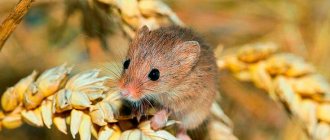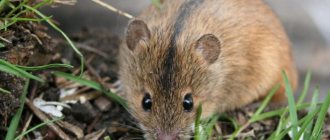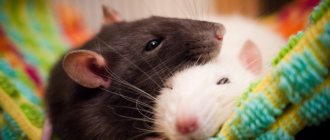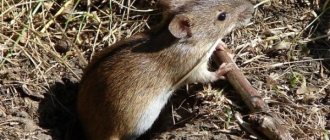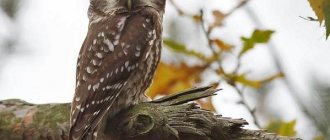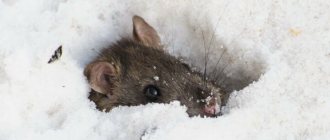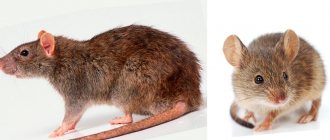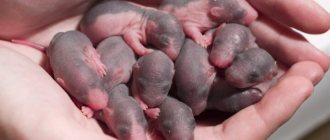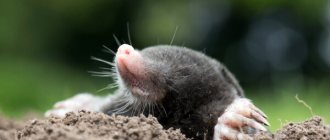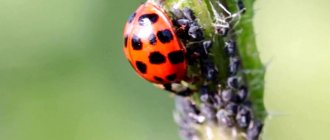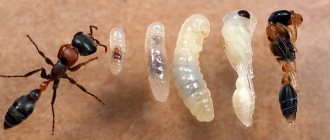The vole mouse or field mouse has been a human companion since ancient times. These small rodents are the closest relatives of house mice and also often live near people.
They are considered pests because they destroy agricultural crops and, in addition, carry pathogens of dangerous diseases.
- 2.1 Wintering
- 5.1 Habitat
Description and appearance
The description of a field mouse will be in many ways similar to other representatives of the mouse family. This is an animal with an elongated pointed muzzle, a round dense body, short legs, and a long tail. Shiny eyes and small pointed ears stand out on the muzzle. The body length of the vole is from 10 to 12 cm, the length of the tail can be from 50 to 70% of the body length. The weight of a mouse rarely exceeds 20 g. The body is covered with thick fur.
Color and physiological characteristics
The vole looks like an ordinary mouse, but it is easy to recognize by its color. On the back and sides, the fur is brownish-brown or reddish-brown, with a clearly visible dark brown or black stripe running down the center of the back. The fur on the belly is light gray. Young vole mice are more brightly colored. With age, the rodent's fur becomes lighter, and some individuals become gray.
Appearance
Interestingly, mice living in the southern regions have larger body sizes and lighter colors.
Differences between female and male
Sexual dimorphism is not typical for vole mice. Males and females do not differ in size or color. Perhaps the only difference is that females have 4 pairs of nipples on their abdomen. But they are not easy to detect in thick fur, so just by looking at a field mouse, it is almost impossible to determine its gender.
What is the difference between a vole and a house mouse?
Field mice are very similar to their domestic relatives. But still, both types have some distinctive features:
- the house mouse is smaller, its size does not exceed 10 cm;
- the fur on the back of the house mouse is dark gray, there is no stripe on the back;
- the house mouse has lighter fur on its belly, almost white;
- house mouse ears are larger and more rounded;
- The muzzle of the house mouse is shortened.
Another difference is that the vole’s tail is slightly longer.
Types of voles
Depending on their habitat, there are several types of field mice:
- common - a brownish-brown rodent with a black stripe on the back;
- red - a bright red mouse with a black stripe on the back, living mainly in the hot steppes of Asia;
- forest - found in the forest-steppe zone of North America and Eurasia;
- underground - most often lives on personal plots and in cities in local areas and in the system of urban communications.
The largest and most widespread group is the common vole.
Habitat
Throughout Russia, Ukraine, Belarus, China, Europe and other countries. They can also be found in China, Mongolia, Denmark, Finland, Korea, and Taiwan. In the Russian Federation, the rodent is distributed in Primorye, Siberia, and the Urals. Prefers hills and mountains. Found near the Black and Azov Seas.
Does not like deserted forest-steppes and continuous forests. It takes root well in moist interfluves. Prefers overgrown meadows, small depressions, collective farm fields, sunny edges of deciduous forests and vegetable gardens. It can be found in greenhouses, greenhouses, cellars, abandoned utility sheds and even in residential premises. With the onset of autumn, rodents move into stacks, haystacks, and stacks of straw.
Features of behavior and lifestyle
Voles are active, even fussy and very voracious rodents. This is explained by the fact that they constantly need to maintain their body temperature, which ranges from 37.5 to 39.0⁰C.
Field mice live in groups. Each group has a leader to whom the rest of the rodents obey. Mice work together to get food, protect themselves from enemies, and raise offspring.
Daily activity directly depends on the time of year. In summer, voles are active at night, in autumn they come to the surface at any time of the day, and in winter they emerge from their burrows mainly during the day. Voles can run quite fast and swim well, but they only get into water as a last resort. If the colony lacks food, mice can migrate long distances.
Wintering
Field mice do not hibernate. They spend the winter in their underground burrows, sometimes climbing to the surface. Basically, in the cold season, voles feed on reserves, which they make throughout the summer and autumn. Sometimes voles settle in houses or cellars for the winter. The owners learn about the wintering of uninvited residents by the remaining large quantities of droppings.
Harm to summer residents and gardeners, farms
In most cases they destroy agriculture. Moreover, they harm both fields with growing plants and granaries. During mass reproduction, irreparable damage is caused. In winter, field mice live in grain stacks and barns.
In gardens and orchards, tomatoes, watermelons, potatoes, carrots, and sunflowers are damaged. If it gets into the cellar, it completely ruins the preparations for the winter. In spring, they feed on shoots and bark of fruit trees.
These mice are carriers of tick-borne typhus fevers and hemorrhagic nephrosonephritis. They can be causative agents of leptospirosis, tularemia, and various erysipelas. The detection of such diseases in humans leads to death.
Reproduction and lifespan
Reproduction of field mice begins with the arrival of warm weather and continues until the first frost. The female bears the offspring for 18–22 days. Usually from 4 to 8 cubs are born. A mouse can become pregnant up to 8 times a year, but more often this happens 3 to 5 times.
Mice are born naked, blind and deaf. They grow quickly, after 2 weeks they see, hear and can run. After 3.5 - 4 weeks they become independent, and after 2 - 2.5 months they reach sexual maturity.
Little mice
How long a vole mouse lives depends largely on its living conditions. The average lifespan rarely exceeds 1.5 - 2 years, but some mice live 5 - 8 years.
Forest Vole Survival Tools
Nature has not equipped voles with sharp teeth, large claws, or muscular legs, but these animals have found a way to survive - they are extremely fertile.
Every year, forest voles give birth to 3-4 offspring.
At one time, a vole gives birth to about 11 babies. Already at 1.5 months, young voles are also ready to reproduce.
One pair of these rodents reproduces up to 1000 times throughout their life, bringing into the world an entire army. This is one of the best survival tools.
Forest voles are good at climbing bushes and trees.
Field mouse diet
Field mice are herbivores, but in order to wear down their ever-growing front incisors, they need to chew on hard objects. These rodents eat a lot; in a day a mouse eats an amount of food equal to its weight.
So, what does a vole eat:
- seeds;
- stems, leaves, buds;
- nuts, cone seeds;
- berries;
- corn;
- bulbs, tubers, root vegetables, roots;
- young bark of berry bushes and broad-leaved trees.
Once inside the house, the vole eats cereals, legumes, baked goods, vegetables and fruits, and will not refuse lard or sausage.
Nutrition
The vole's diet can be called quite varied. These small rodents eat nuts, berries, young shoots and roots of about 80 plant species. On occasion, they will not refuse small insects and snails.
Preference is given to cereals and legumes, in any form: both young sprouts and mature grains are used. In winter, these well-known agricultural pests often live in the basements of private houses and granaries, and also like to gnaw the trunks of fruit trees, feeding on their young bark.
The damage that the common vole annually inflicts on gardeners can only be compared to a locust attack. To repel these small rodents, ultrasonic devices are used, as well as plants whose smell they cannot tolerate. These include mint, thuja, and garlic. Many people also fill the discovered holes with water, but this will not rid the garden of the mouse scourge once and for all.
It is good to make 2-3 poles on the site, which will attract birds of prey, as they will be an excellent observation point for them. For example, an owl can destroy up to 1,200 small rodents in a year. What can we say about predatory animals: a ferret is capable of catching 10-12 pieces per day.
Spreading
Field mice are quite widespread throughout the globe. Important factors that determine their residence in a particular area are the presence of vegetation and sufficient humidity.
Habitat
The vole can be found in many parts of the world. These mice live:
- in Central and Eastern Europe;
- in Mongolia, Korea, China;
- In Kazakhstan;
- in the Urals and southern Siberia;
- in North America;
- in the northern regions of India, in Libya.
Field mice are found in the Ciscaucasia, the Baltic states, and on the coast of the Azov and Black Seas.
Habitats
Voles prefer to inhabit open spaces, for example, meadows, fields, and sparse thickets of bushes. In cities they settle in parks, gardens, and cemeteries. The home of field mice is either natural shelters or holes dug at a depth of 10 cm. The vole's hole is quite simple. It consists of 1-2 nesting chambers, which are connected by tunnels with 3-4 exits to the surface. Voles living in flooded or swampy areas can do without burrows, making nests on the grass or in the branches of bushes.
What benefits do they bring?
After all the above-mentioned troubles from field mice, the question of their benefits may seem ridiculous.
Nevertheless, voles bring tangible benefits , being an important link in the food chain.
Without them, many animals: foxes, martens, owls, cats would be left without food. In addition, by destroying a significant part of the mouse army, these animals preserve many beneficial insects, plants, as well as a significant part of the crops in the fields and gardens.
In nature, there is nothing superfluous , and this is also the case with the field mouse. There is a lot of harm from it, but there is also tangible benefit.
And yet, despite their tiny size and harmless appearance, these are animals that are worth taking into account and it is better not to allow them close to your homes.
Natural enemies
The field mouse is a very prolific animal. This largely explains the fact that the mouse population remains consistently large despite the presence of a huge number of natural enemies. Voles are hunted by:
- birds of prey (owls, hawks, eagles, owls);
- mammals (for some, for example, foxes, ferrets, weasels, badgers, martens, field mice are the main source of food);
- snakes and lizards;
- pets (cats and some breeds of dogs).
Natural enemy
Many animals survive in winter only because they know how to find voles under the snow.
Common vole
1.Appearance
Voles are small rodents, very similar in appearance to mice or rats, but differ from them in their blunt muzzle, short ears and tail, which makes up 30-40% of the body length; The molars are flat, with sharply protruding angular edges on the sides.
The common vole has a brownish-buff or brown upperparts. The belly is dirty white.
The tail is brown above, light below. The length of the animal is 90-140 mm.
2. Distribution
Distributed in the forest, forest-steppe and steppe zones of mainland Europe from the Atlantic coast in the west to the Mongolian Altai in the east. In Russia, in addition to the European part, they also inhabit the south of Western Siberia.
3. Habitats
They live mainly in open places: vegetable gardens, orchards and greenhouses, as well as on crops and damp, swampy areas. Common voles build very complex burrows and place them in colonies.
Their burrows communicate with each other, so that an intricate and widespread network of underground passages is formed. The nests are located at different depths, often up to 35 cm. In the warm season, they do not stock up, but bring food into their burrows to eat it calmly, without fear of enemies, of which voles have many.
4. Nutritional pattern
In the warm season, it feeds on the green parts of cereals, asteraceae and legumes; occasionally eats mollusks, insects and their larvae.
In winter, it gnaws the bark of bushes and trees, including berries and fruits; eats seeds and underground parts of plants.
5. Seasonal behavior
In warm weather, it is active at dusk and at night; in winter, activity is around the clock, but intermittent. In storerooms located in burrows, voles store food for the winter. Stocks reach 3 kg. In winter, voles make their passages under the snow on the surface of the ground and also give birth, placing nests under a large stone, in the remains of straw or hay, in stacks or stacks.
The common vole breeds from March–April to September–November.
In winter there is usually a pause, but in closed places (stacks, stacks, outbuildings), if there is sufficient food, it can continue to reproduce. Voles are very prolific. Females born in spring, under favorable conditions, are able to reproduce at the age of 13 days, and males 40-45 days.
Pregnancy lasts 18-20 days. In a year, common voles give birth to 3-4 broods, each with 5-6 young.
6. Meaning in nature
Voles are one of the main sources of food for many predators - owls, kestrels, weasels, stoats, ferrets, and foxes. These small animals are a real scourge for vegetable gardens and orchards. In winter, they destroy young fruit trees by gnawing their bark, and also eat food stored in barns, pantries and other outbuildings.
The field mouse, often referred to simply as the field mouse, is a rodent whose habitat covers almost the entire continent of Eurasia, in addition to some southern regions. You can meet them in meadows and thickets of various bushes, where they dig burrows for themselves or inhabit empty ones. They hide in these same holes with enviable swiftness, barely sensing minimal danger.
Sometimes they can be seen in large city cemeteries.
For greater safety, these rodents lead a twilight and nocturnal lifestyle, this helps to avoid many predators who will not miss the opportunity to feast on a small animal.
The characteristics of all types of voles are approximately the same, but the easiest way to distinguish them is by the color of their fur.
It is reddish, but depending on the breed it has different shades: ocher, brown, brown. As old age approaches, hair color becomes much lighter, and individual hairs even begin to turn grey. A characteristic element of the color of these rodents is a narrow strip of black fur that stretches along the entire back of the mouse.
The belly is usually white or light gray.
Harm from the life of a vole
By constructing burrows and digging tunnels in the ground, field mice damage the root system of plants, thereby contributing to their drying out and wilting. Mice eat root vegetables, succulent roots, and bulbs, which is why the crop dies. Voles damage plantings of trees and shrubs by gnawing young bark from trunks. They also feast on the above-ground parts of many plants, which is why they die.
Among the favorite foods of voles are seeds and grains of cereals, so mice spoil supplies in granaries and also gnaw vegetables stored in cellars and vegetable stores.
What does it eat?
The feeding behavior of the field mouse is the same as that of small rodents. Even when starving, she will not eat other animals or fish, but she will happily snack on insects. Living in the field, the mouse eats cereals - wheat, oats, corn, buckwheat. And not only the grains themselves, but also the following parts of plants:
- stems;
- spinous processes of spikelets;
- succulent leaves.
Climbing up trees, it gnaws the bark from young branches, eats fruits, and gives particular preference to seeds and dense peels.
Voles living in meadows eat fruits and stems of plants, grains of milky ripeness. They dig up young roots, bulbs and rhizomes, and in the spring they gnaw buds from low bushes. Voles are also attracted to flowers with sweet nectar. In the forests they also do not go hungry. After all, they contain a lot of cones with nuts and young trees with delicate, thin bark.
Mice are the scourge of agriculture. Not only do they destroy crops, but often already harvested grain, stocks of potatoes, carrots, beets, and legumes are destroyed. Once a rodent enters a barn, it remains there forever. It is dry, warm, and has a lot of food. Considering the rate of reproduction of voles, reserves disappear quite quickly.
Harm to humans
In addition to the harm that voles cause to gardeners, damaging plantings and harvested crops, they pose a serious threat to human health, as they are carriers of serious diseases:
- tularemia;
- leptospirosis;
- salmonellosis;
- rickettsiosis;
- pseudotuberculosis;
- toxoplasmosis.
In addition, rodents often settle in country houses, where they can not only spoil food, but also chew furniture, books, candles, and wiring.
How to deal with mice and voles
All methods of controlling rodents can be divided into two categories. The former are aimed at scaring away mice, the purpose of the latter is to destroy voles.
Used for repelling:
- odors (essential oils, chemicals);
- plants (mint, wormwood, tansy);
- ultrasonic repellers;
- homemade repellers (for example, noise-making structures made from tin cans).
More radical ways to control rodents:
- pesticide;
- traps and snares
A fairly effective method is to get a rat-catcher cat. The animal will catch rodents and also scare them away with its presence.
Pest control methods
Due to the danger to human life and health, as well as to all agriculture, the mouse is exterminated in every possible way. To limit the number of individuals there are the following methods:
- passive-preventive, in which mice are repelled from areas and objects of human activity;
- active, which uses methods for the complete destruction of pests.
The smell of a number of plants repels field mice; such protection is classified as a passive type of protection.
Repellent method
Plantings of odorous plants that mice cannot tolerate are effective in repelling them. These include:
- calendula;
- garlic;
- onion;
- sagebrush;
- mint;
- tansy and other herbs and plants with an intense odor.
Essential oils of plants are also used. You need to moisten cotton pads in liquid and place them in places where mice are expected to appear. You can use ammonia or kerosene. Rodents also try to avoid tree ash.
If you do not want to harm field mice, you can use a sonic repeller
Vibrating or ultrasonic devices are considered a more humane method of repelling, because of which rodents feel uncomfortable and run away. Such devices can be found in specialized gardening stores, or you can also make them yourself.
To make the device, you need to bury a stake in the ground, onto which a plastic bottle is placed. In windy weather it will spin and rattle, scaring away rodents. By analogy with a bottle, you can use tin cans or even bells.
It is unlikely that a colony of pests will remain in an area that is under the supervision of a hunter cat.
Physical destruction
In such a “war” any means are good. In a situation where the harvest is in danger, even the most extreme measures are justified. In folk methods of getting rid of mice, there are several options for battle:
- Plaster thrombus. You need to mix flour and gypsum (or lime) in equal parts and add a little salt. A mouse that eats this mixture will develop a blood clot in its stomach and die.
- I. In pesticide stores you can buy special anti-rodent preparations. They are presented in the form of granules or tablets. You must strictly wear gloves when laying out the poison, otherwise cautious mice will not even approach the bait. Some poisons take time to act and poisoned individuals infect others during this period. If there is a cat on the property that can eat a dead mouse, it is better not to use this method, otherwise the pet may also die.
- Mechanical destroyers. The method using mousetraps is only effective when there are only a few mice living in the area.
- Traps. People invent different types of devices for catching mice. For example, glue is applied to the base and bait is placed in the center. The mouse, having approached the food, becomes glued and cannot escape. You can also buy a trap in a store.
Traps and baits should be laid out with gloves, the smell of a person repels mice
Sometimes mice cause such harm to a household that a real war is waged against them. It is better to use chocolate, meat or bread dipped in unrefined sunflower oil as bait rather than cheese.
Consequences of complete extermination
During the years of demographic decline of mice, populations of owls, foxes and other animals and birds that feed on mice suffer. Some species of voles are considered rare and are protected by law. These are the mice:
- Muyskaya;
- Central Kashmir;
- Balukhistan;
- Taiwanese;
- Evoronian;
- Japanese;
- Mexican.
Prevention measures
To reduce the likelihood of voles becoming infested, various methods are used. Some of them:
- get a pet cat or dog;
- do not drive away natural mouse enemies from the site;
- clear the area of rubbish in which rodents can live (old furniture, boards, fabrics, etc.);
- loosen the ground, destroying mouse passages;
- Get rid of any garden debris that might harbor mice.
For effective control, it is better to use several methods, which also include prevention.
Any living creature living on the planet occupies a certain place in the ecological sphere. By eating plant seeds, mice control the growth of grass, which prevents trees from emerging. This way the forest is preserved. Rodents are also an important link in the predator food chain.
